
Happy birthday Little Richard!
Here’s 26 red hot minutes of the High Priest of rock and roll performing at the Olympia Theater in Paris in 1966. And the crowd goes wild!
Play it loud.

Happy birthday Little Richard!
Here’s 26 red hot minutes of the High Priest of rock and roll performing at the Olympia Theater in Paris in 1966. And the crowd goes wild!
Play it loud.
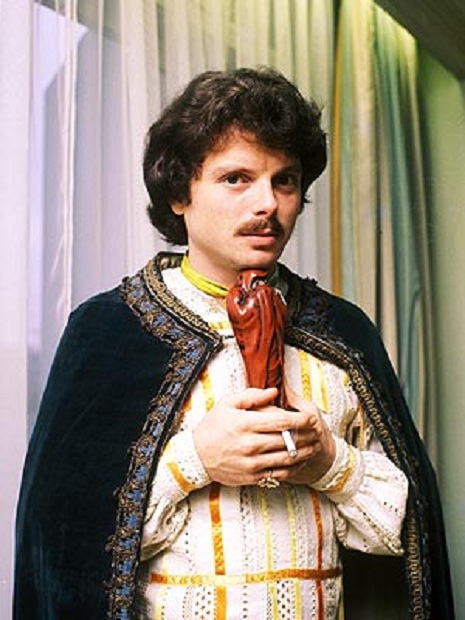
In 1967, Scott Mckenzie’s “San Francisco (Be Sure to Wear Flowers in Your Hair)” was a clarion call to young kids who, like myself, were isolated in the soul numbing suburbs of America. Yes, the song is naive and somewhat corny, but in its day it really was an anthem for a generation of disaffected white kids looking for something beyond the high school walls. It worked for me.
By the time I arrived in the Haight Ashbury in 1968 the Summer of Love had passed and the neighborhood was gradually becoming a cattle yard for runaways. Tourist buses clogged the streets, sightseers were everywhere and kids with no money were spare changing and ripping off weekend hippies by selling them bogus drugs. I spent most of my time on Hippie Hill in Golden Gate Park reading books of poetry that I’d borrowed from City Lights Bookstore in North Beach (thanks Lawrence).
The flowers of the counterculture were starting to wilt, but it was still a great time for a rock and roll fan to be living in San Francisco. I was going to concerts at the Matrix and The Fillmore seeing Traffic, The Incredible String Band, Eric Burdon and War, It’s A Beautiful Day, Albert King, The Dead (who I’ve never liked, now or then) Big Brother and The Holding Company, Country Joe and The Fish, The Peanut Butter Conspiracy, The Jefferson Airplane, Quicksilver Messenger Service - a shitload of music, both great and not so great. But even the not so great stuff was still mindblowing to a 17 year old kid from Falls Church, Virginia.
For the record, I never wore a flower in my hair.
Here’s a seldom seen video from French TV of Mckenzie singing his big hit written by John Phillips.


Hey, it’s a new video of psychedelic impressionism by my bro, Josh Laner for another song from my recent LP, Natural Selections. The song itself, entitled Brain is a collaboration with my long time friend, the wonderful Canadian singer/songwriter/producer Jordon Zadorozny. Stop, look and listen, won’t you ?

Just $27.50 for soft bouncin’ bouncin’ curls.
Thanks Joe Janacek via ?uestlove !
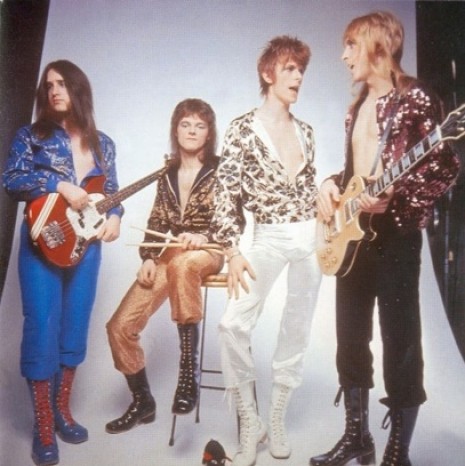
David Bowie was on a roll when he recorded “Suffragette City”, he was writing enough songs for his own catalog and for others to record. He’d already given Peter Noone of Herman’s Hermits “Oh! You Pretty Things”, which was quite a move for the toothsome pop star but, as rock writer Charles Shaar Murray noted, Noone’s version was “one of Rock and Roll’s most outstanding examples of a singer failing to achieve any degree of empathy whatsoever with the mood and content of a lyric.” Noone was possibly thinking about dental hygiene and girls rather than Aleister Crowley and philosopher Friedrich Nietzsche, whose ideas are referenced in the song. Bowie had also tried his hand at punting a teenage dress-designer into pop stardom with “Moonage Daydream” and then offered his services to Mott the Hoople.
Hoople were a superb band who hadn’t broken through to the level of success they deserved. Bowie was a fan and on hearing Mott were about to split, offered their lead singer, Ian Hunter, the song “Suffragette City” to record, if the band would stay together. Hunter felt it wouldn’t be a hit, and knew that after a few chart failures he had to have a winner. He therefore asked Bowie for “All the Young Dudes” which Hunter saw as a definite hit, it was and became an anthem for a generation of British youth. “All the Young Dudes” had originally been a part of Bowie’s plan for a concept album that told the story of an alien saving the Earth from destruction, which would become Ziggy Stardust.
“Suffragette City” was written in 1971 and recorded in January 1972. It gives a big nod towards The Small Faces “Wham Bam Thank You Ma’m”, and references (via the word “droogie”) Anthony Burgess’ A Clockwork Orange, which was the hit film of that year.
Infamously, when Bowie performed “Suffragette City” at the Oxford Town Hall in June 1972, he was photographed by Mick Rock apparently simulating oral sex on Mick Ronson’s guitar. Bowie was actually playing the guitar with his teeth. However, Rock’s photo was so iconic that Bowie convinced his manager, Tony Defries, into buying a whole page of advertising space in the UK music weekly, Melody Maker.
The line-up for the recording of “Suffragette City” was David Bowie: Vocals, Guitar; Mick Ronson: Guitar, piano and ARP synthesizer (which doubles as the saxophone); Trevor Bolder: Bass; Mick Woodmansey: Drums.
David Bowie - Vocals
Mick Ronson - Guitar
David Bowie and Mick Ronson - Acoustic Guitar, Piano and FX
Trevor Bolder Bass
Bonus Clip Small Faces “Wham Bam Thank You Mam”
Bonus Clip David Bowie - “Suffragette City” 1972
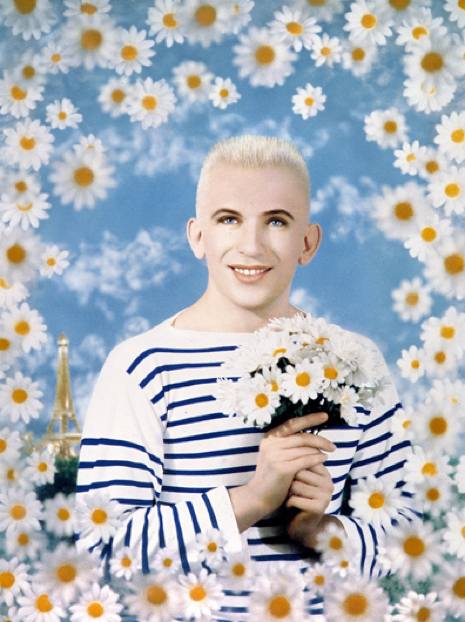
Portrait of Jean-Paul Gaultier by Pierre et Gilles
As posted at Jezebel recently, I was happy to be reminded of this incredible, yet unjustly obscure, music video for the “House couture” single “How To Do That” by French fashion designer (and former Eurotrash TV host), Jean-Paul Gaultier. Stored in my garage, I actually have an obsolete format 3/4” videotape of this piece that someone gave me when it came out in 1988. It’s on the director’s reel of Jean-Baptiste Mondino.
The 12” record had a “laser etching” on the vinyl itself of scissors, needle and thread and Gaultier’s logo. The CD has multiple remixes of this song—which is awesome—over and over again (but this is the best mix by far). Featuring Naomi Campbell, Gaultier’s signature cone bras (that Madonna would later make famous) and a dusky gray/purple blazer with 17 buttons up the front and 12 on each sleeve whicht I sheepishly admit to owning at the time…
Hey, it was the 80s, what more do I really have to say?

I’m jumping aboard the ‘isolated tracks’ bandwagon (at the risk of hurling it off the edge of its already wobbly reality into the pit of oblivion) with this breakdown of The Ramones “Blitzkrieg Bop,” the debut single off their first album The Ramones released in1976.
In total, the album took seven days to record; the instruments taking three days and vocals taking four days. It also took $6,400 to record. Joey related: “Some albums were costing a half-million dollars to make and taking two or three years to record.” The band recorded using the same mic placement techniques as many orchestras used to record pieces.
The guitars are heard separately on the stereo channels — electric bass on the left, rhythm guitar on the right channel; drums and vocals are mixed in the stereo mix in the middle.”
My buddy Mickey Leigh, Joey’s brother, says The Ramones was recorded on 4 tracks. As much as I want to believe it, I have my doubts.There’s got be a couple of extra tracks in there for backup vocals and effects. But, maybe not. Producers Craig Leon and Tommy Ramone would know. Hey guys, help me out.
Tommy on his drumming style:
I just played what I wanted to hear, what I thought was necessary. I designed the drum parts specifically for the songs—they were constructed in a way that would fit the songs perfectly. They would wrap around the songs, or the songs would wrap around the drums. The whole thing has to work as a unit, sort of as a framework. We tried to coordinate everything so that everything would be one unit like that. The closest things to an influence would be people like Charlie Watts or Al Jackson. But, I didn’t really listen to drummers, I basically played what I thought was needed for the Ramones.”
Johnny described his down stroked, buzzsaw guitar style as “pure, white rock ‘n’ roll, with no blues influence.”
Joey’s vocals sound like Ronnie Spector with a dick and a Brit inflected Queen’s (N.Y.) accent. (Ok, he didn’t have Ronnie’s range, but he had the ‘eh hos’ down).
Dee Dee plays loud and could count to 4. But, he couldn’t sing and play at the same time. Which is fucking ok. His bass playing was steady, propulsive and inexhaustible. His 1,2,3,4 mantra was utterance enuff, lodged in the collective consciousness of punk with the absoluteness of the 11th commandment of rock and roll.
How do you deconstruct the deconstructed?
2 minutes of stripped down, locked in, tight rock and roll. Everything in its place, doing exactly what it has to do. Intensely focused. Like Zen.
The sound that launched a revolution and a primer in punk rock for you kids out there.
Johnny, Dee Dee and Tommy after the jump…
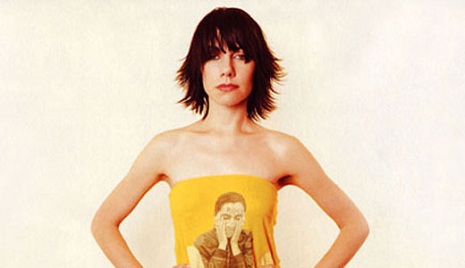
‘Written On The Forehead’ from PJ Harvey’s upcoming album Let England Shake (February 15, Vagrant Records).
I was cool to this at first, but I’ve grown to really dig it. Fragile, trippy, lovely. The sample of Niney The Observer’s ‘Blood And Fire’ is so unexpected and strange and yet so…perfect.
Recorded in a 19th Century church in Dorset with long time collaborator Flood who co-produced the album with PJ Harvey, John Parish and Mick Harvey. Let England Shake was also mixed by Flood”.
Fan made video:
“Blood And Fire” by Niney The Observer after the jump…
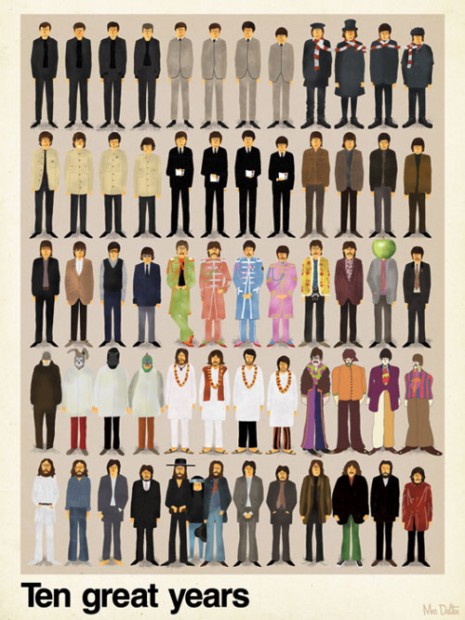
Here’s a stylish limted edition print by Argentinean-based artist Maxim Dalton. You can order “Ten Great Years” for $55.99 here.
See close-ups of the print after the jump…
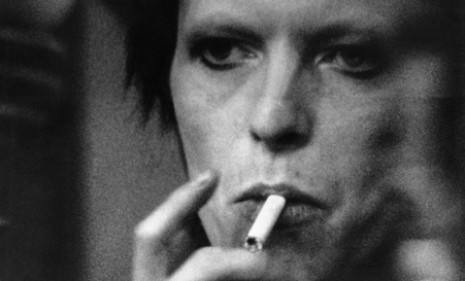
David Bowie first released “Moonage Daydream” under the project name Arnold Corns, which was one of Bowie’s side interests, a group set up for 19-year-old dress designer Freddie Burrettia to front. The original band had been assembled in Dulwich College, the name inspired by Pink Floyd’s song “Arnold Layne”, and when Bowie agreed to write some songs for Burrettia in 1971, he revived Arnold Corns, with his regular line-up of Mick Ronson (guitar), Trevor Bolder (bass), Mick ‘Woody’ Woodmansey (drums), with Bowie and Freddie on vocals.
Arnold Corns’ version of “Moonage Daydream” was recorded in April ‘71 and released as a single in May of that year, with “Hang on to Yourself” as its B-side. The song tells the story of an alien messiah, who is born to save the world from impending disaster. Surprisingly, it was a flop, but Bowie recognized he had hit on an idea that was too good to waste, and developed it for the album Ziggy Stardust and the Spiders from Mars.
Ziggy was a mini-concept album, really a sequence of related songs, as Bowie later explained to William S. Burroughs in Rolling Stone magazine:
The time is five years to go before the end of the earth. It has been announced that the world will end because of lack of natural resources. Ziggy is in a position where all the kids have access to things that they thought they wanted. The older people have lost all touch with reality and the kids are left on their own to plunder anything. Ziggy was in a rock-and-roll band and the kids no longer want rock-and-roll. There’s no electricity to play it. Ziggy’s adviser tells him to collect news and sing it, ‘cause there is no news. So Ziggy does this and there is terrible news. “All the Young Dudes” is a song about this news. It’s no hymn to the youth as people thought. It is completely the opposite…
The end comes when the infinites arrive. They really are a black hole, but I’ve made them people because it would be very hard to explain a black hole on stage…
Ziggy is advised in a dream by the infinites to write the coming of a Starman, so he writes “Starman”, which is the first news of hope that the people have heard. So they latch onto it immediately…
The starmen that he is talking about are called the infinites, and they are black-hole jumpers. Ziggy has been talking about this amazing spaceman who will be coming down to save the earth. They arrive somewhere in Greenwich Village. They don’t have a care in the world and are of no possible use to us. They just happened to stumble into our universe by black hole jumping. Their whole life is travelling from universe to universe. In the stage show, one of them resembles Brando, another one is a Black New Yorker. I even have one called Queenie, the Infinite Fox…Now Ziggy starts to believe in all this himself and thinks himself a prophet of the future starmen. He takes himself up to the incredible spiritual heights and is kept alive by his disciples. When the infinites arrive, they take bits of Ziggy to make them real because in their original state they are anti-matter and cannot exist in our world. And they tear him to pieces on stage during the song ‘Rock ‘n’ roll suicide’. As soon as Ziggy dies on stage the infinites take his elements and make themselves visible.
The album Ziggy Stardust… was mainly recorded over the Fall of 1971, and then finished during a week in January 1972. It was recorded at Trident Studios in Soho, London, the first studio to boast an 8-track recording machine in 1968, and by the early 1970s the first in Europe to have a 16-track recorder. Trident was where The Beatles recorded “Hey Jude” and was a popular studio for the likes of T.Rex, Queen, Supertramp and Bowie.
Recording started in September with “It Ain’t Easy”, then a longer session during the first two weeks of November produced “Hang on to Yourself”, “Ziggy Stardust”, “Rock ‘n’ Roll Star” (later shortened to “Star”), “Moonage Daydream”, “Soul Love”, “Lady Stardust”, and “Five Years”. Two covers were also laid down then, Chuck Berry’s “Round and Round” and Jacques Brel’s “Amsterdam”. The album was finished in January 1972 with the recording of “Starman”, “Suffragette City”, and “Rock ‘n’ Roll Suicide”.
Bowie was producer and had definite ideas for how the record would sound, as co-producer, recording engineer and mixing engineer, Ken Scott recalled in 1999:
“I remember David coming to me, prior to doing the album, and saying, “You’re not going to like this album. Its gonna be much harder.” I don’t know who he compared it to; maybe it was Iggy. He thought I would hate it, but I loved it!
“We recorded quickly, just as we always did. We generally worked Monday through Saturday, 2:00 p.m. until we finished, generally midnightish - not much later, eat when we felt like there was a natural break, and spent 2 to 3 weeks recording and 2 weeks mixing.
“Nothing was recorded 100% live. There were over dubs on every track, some more than others. If memory serves me well, fat chance after 27 years, “Round and Round” had the least. On Ziggy Stardust the basics were virtually the same for all the tracks. It was only the nuances in each song that would vary. The sessions weren’t much different to any of the other Bowie sessions.
The line-up was David Bowie – vocals, acoustic guitar, saxophone, piano, harpsichord; Mick Ronson – guitars, piano, backing vocals, string arrangement; Trevor Bolder – bass; Mick Woodmansey – drums.
Bolder, Woodmansey and Scott have since said “Moonage Daydream” was the best track from Ziggy Stardust, with Bolder saying in 1976:
“...I liked “Moonage Daydream”... I think, [it] had a lot of feel. I think it had more feel on-stage than it did on the album. When we used to do it on-stage it used to be fantastic. It really used to get the kids going. That would start the kids off. When they wanted to go - we would do that number about four before the end. and that would lift the audience up . I think the audience liked to hear it live. Every night you knew that “Moonage Daydream” was going to be the one that really lifted them. Then we’d go and follow on from there to the end.”
While Woodmansey also said in 1976:
“My favourite on that [album] was “Moonage Daydream” as far as like ....feeling goes, you know, as far as actually getting something out of the track when you listen to it back.”
The Ziggy Stardust Companion ran an online poll on this question from 1999-2001 the results of 828 fans polled their favorite track was “Moonage Daydream”. The berakdown was as follows:
The results showed that “Moonage Daydream” was the most popular track with 20% of the vote, followed by “Starman”, “Ziggy Stardust” and “Rock n Roll Suicide” with 14% each. “Lady Stardust” (11%) and “Five Years” (9%) were next most popular. “Soul Love” (6%), “Suffragette City” (5%), “Hang Onto Yourself” (4%) and “Star” (2%) made up the remainder of the total vote.
David Bowie - Vocals
More tracks from ‘Moonage Daydream’ after the jump…
With thanks to Richard Metzger